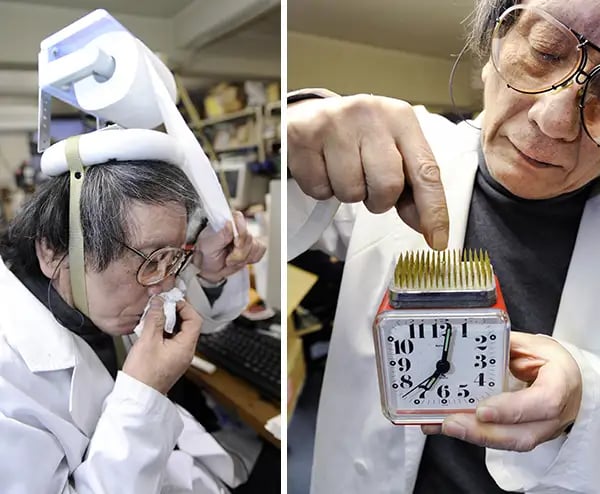At first glance, Matty Benedetto’s workshop in Burlington, Vermont is the typical inventor’s lair.

Buckets of screws, springs, nuts, and bolts line the shipping-container-sized room. In one corner, there are 5 3D printers and a Glowforge laser cutter; in another, an assortment of spray paint cans and filaments.
But the creations that line his shelves tell a different story.
On Benedetto’s self-described “wall of unnecessary,” you’ll find a world of whimsy: Pants with transparent pockets that are designed to hold slices of pizza; a mini-bed for an iPhone; a solar-powered t-shirt; gloves fashioned to look like Crocs.
Any serious entrepreneur knows that you shouldn’t create solutions to problems that don’t exist. But Benedetto has made a full-time living out of doing just that.
Benedetto’s inventions are partly a critique of modern capitalism. But they’re also a call to action — a reminder that we should all put our ideas out into the world, no matter how zany they may be.
A 14-year-old businessman
Benedetto got his start as an entrepreneur back in 2004, at the ripe age of 14.
A self-proclaimed winter sports nut, the New Yorker spent much of his free time on the popular ski forum, Newschoolers, where some posters formed a “crotchet cult” and encouraged each other to make their own ski wear.
With some mom-assisted training, Benedetto started crocheting beanies for his friends. Soon, he was getting so many requests that he decided to launch his own business.

Matty Benedetto sporting some of his early ski wear (Ida Benedetto)
At 15, he gathered up his savings from a summer lifeguard job, formed an LLC, and built a website. Using Alibaba, he formed a manufacturing partnership overseas and began outsourcing his beanie production to China.
“I remember rolling up to the seaport to pick up my first order,” he says. “It was just me and my mom in an SUV, surrounded by all these massive shipping containers and corporate trucks. We barely fit everything in the car.”
Benedetto grew the company into a premier ski brand, which he ran out of his dorm room while studying marketing at Saint Michael’s College in Vermont.
When sales eventually flatlined, he pivoted the company into a tech accessory brand. Capitalizing on his textile connections, he was one of the first retailers to market and sell those now-ubiquitous colorful woven iPhone cables.
But in February of 2019, with his suppliers virtually shut down for Chinese New Year’s, the beanie bro began to ruminate on old discarded ideas.
“Along my journey as an entrepreneur, I’d had all these completely crazy, out-there ideas I’d written down in the notes app on my phone — products that served no purpose whatsoever, and were so dumb that I’d never dared to make them,” he says. “But I figured, ‘Why not just put them out there?’”
The useless invention influencer
The products on Benedetto’s list shared a theme: They solved non-existent problems.
He started off with a pair of chopsticks that snap onto the bottom of Apple Airpods.
Benedetto bought a 3D printer, taught himself how to use Fusion 360 (a 3D design program), and had the final product printed out in a few days. He posted his invention to Reddit, with the caption, “I like to design products for fun that no one is asking for.”
Miraculously, the post hit the front page of the social site and garnered 54k upvotes.

Benedetto’s AirSticks — the first of many pointless inventions (Matty Benedetto)
Benedetto acted quickly on his front-page fame. Under the moniker Unnecessary Inventions, he launched a website, an Instagram, and a YouTube account and began building as many as 7 new inventions each week.
More than a year later, Benedetto has cranked out 187 “unnecessary” inventions. Among his hits:
- The Hoverbrella: A mini umbrella attachment for a drone.
- The FurRoller: A device that covers your clothes with fake animal hair so you can pose as a dog owner/lover.
- The Sobbing Spectacles: A pair of glasses with built-in sponges to collect tears.
- The FingerBeanies: A set of mini beanies that cover just your fingertips.
- Avocado on a Stick: A more efficient way for millennials to make avocado toast.
- The Century Charger: A 100-foot iPhone cable.
- The Cuisine Curtain: A cloth that attaches to your nose and covers your mouth, allowing you to “eat in privacy.”
- StubStoppers: A pair of mini hardhats that protect your toes.
- The Kazuul: A vape pen that doubles as a kazoo.
- SuperSolar Shirt: A t-shirt with a built-in charging solar panel.
- Chip-Xractor: A suction device that retrieves the last chip from a Pringles can.
- The Mixer Mask: A face mask that doubles as a beer receptacle.
- A belt buckle that doubles as a bubble wrap popper.
His process is quick and cheap: The typical invention costs around $5-$20 in 3D printer filament and takes anywhere from a few hours to a few days to produce. Once it’s done, he takes it out for a spin in public to make sure it’s functional.
“I’m not an engineer,” he says. “I really just kind of hack it together. Sometimes, I have to stand still while taking a photo, or the whole thing will fall apart.”
This small investment has landed him viral internet fame, guest appearances on talk shows, and more than 2m followers across his social channels. One invention — a pair of gloves fashioned to look like a pair of Crocs — even earned him a cease and desist letter. (He later had to change the name from “Croc Gloves” to “Gator Gloves.”)

Benedetto proudly displays a cease and desist letter he received from Crocs (Matty Benedetto)
On a typical day, he’s up at 5:30am and in his mad scientist lab by 8. He’ll spend the day mocking up designs, printing out plastic parts, and photographing the final inventions with a makeshift camera setup.
When I called him on a recent Tuesday afternoon, he was working on his latest project: An attachment that allows you to use your shoe as a cupholder while sitting cross-legged. A few days later, it had 26k likes on Instagram.
How does he come up with such ridiculous ideas?
“These inventions are all I ever think about,” he says. “It could be the smallest little thing that happens in my daily life — walking down the street and seeing someone do something a very particular way. A lot of it is just observing human behavior.”
The key, he says, is to find some tiny issue that people can relate to — something so insignificant that it doesn’t warrant any kind of innovation — and iterate an extremely overwrought solution.

An array of Benedetto’s inventions (Matty Benedetto)
A crucial aspect of Benedetto’s inventions is that they’re typically not for sale.
He makes a full-time living primarily through brand partnerships with the likes of Call of Duty, DoorDash, and the Almond Board of California, who pay him to create custom unnecessary inventions. Recently, Bud Light requested an iPhone case with a fold-out cup holder.
He says 2 of these deals per month comfortably make up a full-time living.
“I’m more like a marketing studio than an influencer,” he says. “I make a standalone campaign around one specific item, rather than smiling with some gummy bears that make your hair grow.”
He’s only recently experimented with parlaying one of his inventions — a coffee table that doubles as a jigsaw puzzle — into a sellable product. A Kickstarter for the project has raised nearly $100k so far, 10x his initial goal.
“The key to this whole thing is just having fun and remembering it’s all a big joke,” he says. “But at the end of the day, I still have to take it seriously enough to pay my bills.”
The art of chindōgu
While Benedetto introduced unnecessary inventions to a young, digital-savvy audience, he didn’t pioneer the concept. That distinction goes to one Kenji Kawakami.
Back in the early 1990s, Kawakami was the editor of a Japanese home shopping magazine called Mail Order Life, a Sharper Image-esque catalog that marketed expensive gadgets to suburban housewives.
In the blank back pages of the publication, Kawakami would jokingly include his own useless creations, which he dubbed “chindōgu” (roughly “weird tool” in English).
The inventions — which included the likes of a solar-powered flashlight, a zen kitty litter box, and a precursor to the selfie stick — gained a cult following in Japan. With the help of an American journalist, Kawakami launched the International Chindōgu Society and spread the gospel of useless inventions across the world.

Kenji Kawakami demonstrates two of his inventions: A “Hayfever Hat” that dispenses toilet paper, and an alarm clock designed to keep users awake. (Photo by YOSHIKAZU TSUNO/AFP via Getty Images)
Kawakami, who was a radical student protester in the 1970s, has said that Chindōgu is a rebellion against the tyranny of consumerism. “I despise materialism and how everything is turned into a commodity,” he once told a reporter.
Over the years, he refused to capitalize on the success of Chindōgu, donating proceeds from books to charity. Profit was counter to his vision.
Benedetto’s iteration of the concept isn’t as anarchist — but it’s still at least partially a critique of the stuff that clogs the arteries of the modern e-commerce landscape.
“When people see my stuff pop up in their Instagram feeds, they often think they’re ads for real products,” he says. “But what I’m really doing is making fun of all the stupid products that actually exist — the type of stuff you see for sale on Wish.com and wonder, ‘Who pays money for this crap?’”
But Benedetto also hopes that Unnecessary Inventions can serve as a call to action for gun-shy entrepreneurs.
“None of this would’ve happened if I didn’t just put it out there,” he says. “Just start something and share it with the world. Trust me: Nothing is too stupid.”

